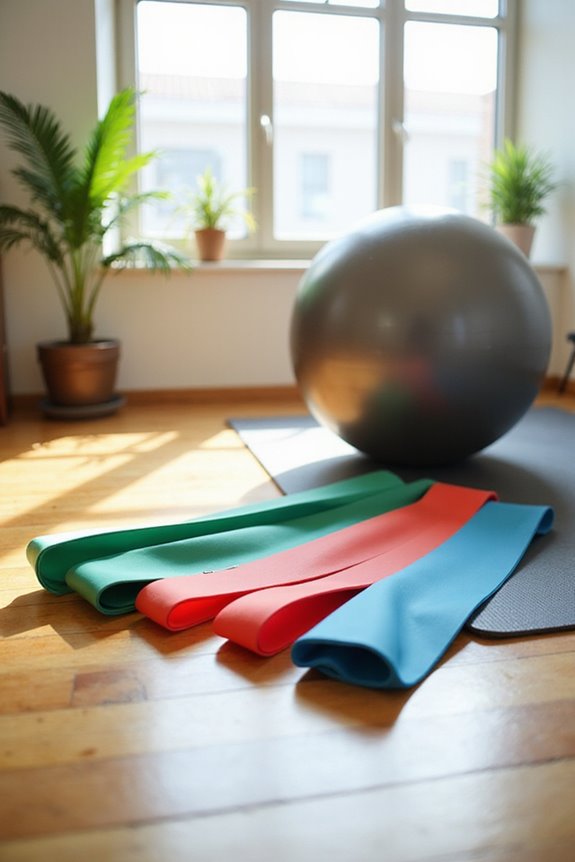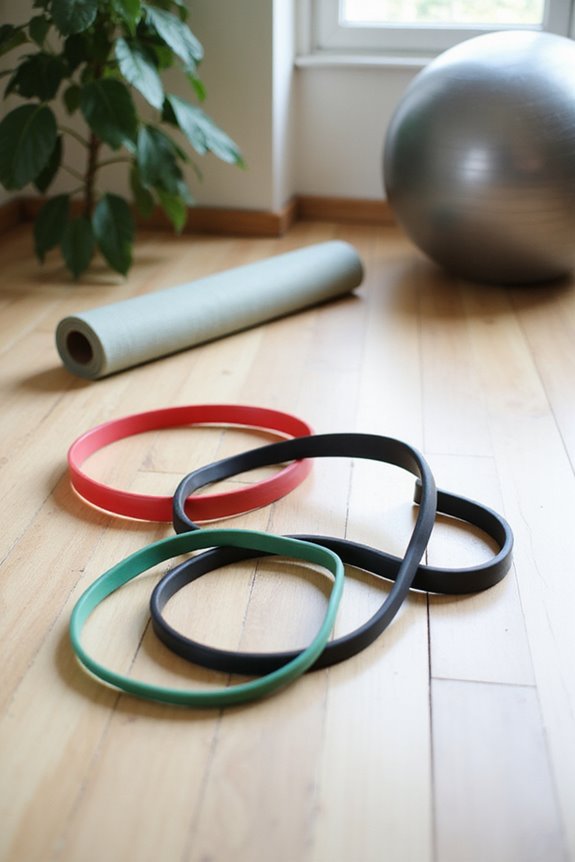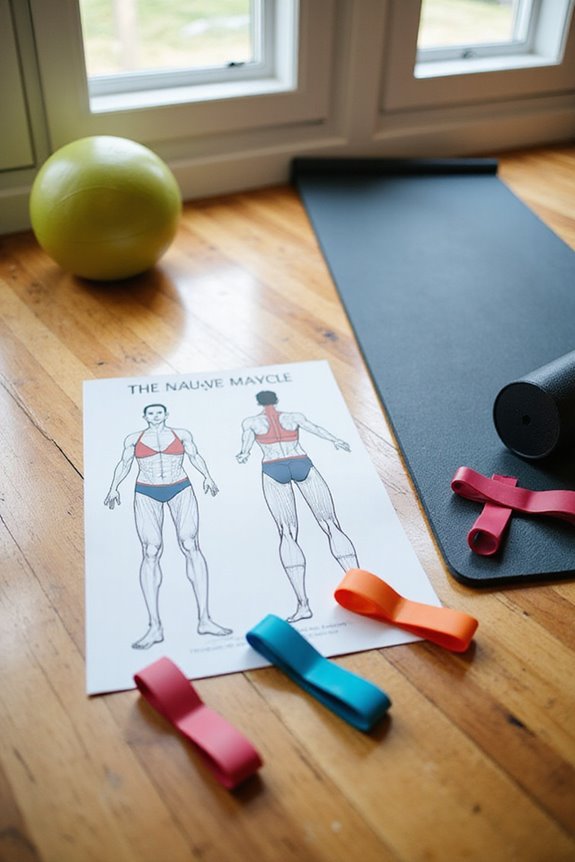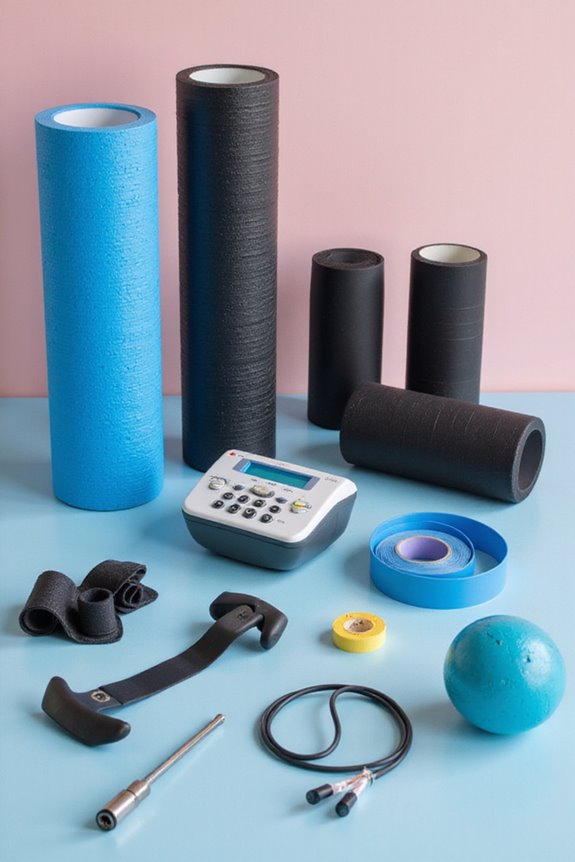Resistance bands effective for core strength include:
- Loop Bands: Ideal for isotonic exercises.
- Tube Bands with Handles: Offer versatile grip options.
- Therapy Bands: Suitable for rehabilitation and moderate strengthening.
- Figure-8 Bands: Focus on oblique muscles.
- Mini Bands: Provide resistance for limbs during core exercises.
Utilizing these bands enhances muscle engagement, injury prevention, and overall training efficiency. Understanding how to integrate these tools effectively can further improve workout results.
Key Takeaways
- Loop bands are ideal for isotonic exercises, providing continuous tension for better core engagement during workouts.
- Tube bands with handles offer versatile grip options for various core-strengthening movements, enhancing stability and control.
- Mini bands are effective for ankle or wrist resistance, targeting specific core muscles during exercises like lateral walks and leg lifts.
- Banded Russian twists and Pallof press variations specifically improve rotational strength and anti-rotation stability, crucial for core development.
- Therapy bands are excellent for rehabilitation and moderate strengthening, supporting low-impact core exercises while minimizing joint stress.
Types of Resistance Bands for Core Workouts
Resistance bands come in various types, each designed to enhance core workouts through distinct characteristics and functionalities. Understanding the differences in band materials and band designs is essential for optimizing performance.
Types of Resistance Bands:
- Loop Bands: Continuous bands ideal for isotonic exercises.
- Tube Bands with Handles: Versatile grip options for various movements.
- Therapy Bands: Flat bands for rehabilitation and moderate strengthening.
- Figure-8 Bands: Target obliques through controlled rotation.
- Mini Bands: Small bands for ankle or wrist resistance.
Tension Levels:
- Light Resistance: Suitable for beginners.
- Medium Resistance: Challenges core with controlled repetitions.
- Heavy and Extra Heavy: For advanced users seeking maximal engagement.
Selecting the appropriate band type and tension level can greatly impact core workout effectiveness and engagement.
Key Core Exercises Utilizing Resistance Bands

Core strength is essential for overall fitness and functional movement. Resistance bands offer versatile core exercise variations that enhance stability and strength. Key exercises include:
- Pallof Press Variations: Improve anti-rotation stability, targeting obliques and lower back.
- Banded Russian Twists: Focus on rotational strength, enhancing core endurance.
- Banded Dead Bugs and Knee Tucks: Engage deep abdominal muscles and improve coordination.
- Side Plank Rows: Combine lateral strength with upper back engagement.
- Banded Chops and Forward Raises: Develop anti-rotation control and core stability.
These exercises leverage resistance band benefits, allowing users to adjust tension and incorporate functional movement patterns. This adaptability makes resistance bands effective for individuals at varying fitness levels seeking thorough core strengthening.
Advantages of Resistance Bands for Core Training

When evaluating the advantages of using bands for core training, it becomes evident that these tools offer unique benefits that enhance muscle engagement and functional performance.
Continuous Muscle Engagement
- Bands provide constant tension, ensuring greater muscle stimulation than free weights.
- Continuous engagement enhances core activation, improving form and balance.
Enhanced Core Stabilization
- Resistance bands require active stabilization, essential for injury prevention and balance.
- They offer versatile training across multiple planes, mimicking real-life movements.
Injury Prevention and Rehab Benefits
– Low-impact resistance reduces joint stress, facilitating safe strengthening post-injury.
Improved Strength Levels
- Bands greatly enhance core strength and athletic performance.
- Combining band work with traditional methods improves overall training efficiency, offering substantial band benefits.
Structuring a Core Workout With Resistance Bands

Developing a structured core workout with resistance bands can enhance muscular engagement and stability. A well-defined core workout structure typically begins with isometric holds to activate deep core stabilizers, followed by rotational movements to target the obliques.
- Utilize multiple bands of varying tension to adjust workout intensity.
- Perform 2-3 sets of isometric holds lasting 60 seconds, alternating directions for balanced development.
- Incorporate exercises like banded Russian twists and dead bugs to target both anterior and posterior core muscles.
- Allow 60-90 seconds of rest between sets to maintain form and performance.
- Regularly rotate exercises to challenge core muscles and prevent adaptation.
This structured approach guarantees effective engagement and thorough development of core strength.
Targeted Core Muscle Groups Engaged by Resistance Bands

Resistance bands effectively engage various core muscle groups, offering a versatile approach to strengthening and stabilizing the torso.
Rectus Abdominis Engagement
- Exercises such as banded bicycle hovers and tabletop toe taps activate the rectus abdominis, vital for spinal flexion.
- The bands create increased tension, enhancing strength gains as muscles work harder to maintain flexion.
- Dynamic movements like band twists improve muscle fiber recruitment and endurance.
Obliques Activation
- Band-resisted side bends and rotational twists engage both external and internal obliques, critical for rotation and lateral movements.
- Anti-rotational exercises, including the pallof press, promote oblique stability against unwanted spinal rotation.
- Resistance bands increase load during twisting, enhancing overall core rotational power and spinal protection.
Selecting the Right Resistance Band for Core Strength
Selecting the appropriate resistance band for core strength training is crucial for optimizing workouts and achieving desired fitness outcomes.
Band Material Selection
- Latex bands offer high elasticity and durability.
- Fabric bands provide better grip and comfort for prolonged use.
Resistance Level Evaluation
- Light bands are suitable for beginners focusing on endurance.
- Medium bands cater to intermediate users aiming for progressive strength.
- Heavy bands are designed for advanced training and muscle hypertrophy.
Portability and Usability
- Lightweight bands are easily transportable for workouts anywhere.
- Anchor-compatible bands facilitate various core exercises, enhancing versatility.
Cost and Accessibility
- Basic loop and mini bands are low-cost, while tube bands with handles are pricier but offer enhanced functionality.
- High-quality bands guarantee durability and effective resistance throughout their use.
Techniques for Effective Resistance Band Use
Utilizing resistance bands effectively requires an understanding of various techniques that enhance core strength training outcomes.
Band Anchoring
- Securely anchor bands to stable objects at hip height for ideal core exercises.
- Use double-wraps or door anchors to enhance stability during dynamic movements.
- Always test the anchor point to verify it can withstand intended tension.
Exercise Variations
- Incorporate isometric exercises, such as Pallof press holds, for stabilization.
- Utilize rotational movements, like Russian twists, to target obliques.
- Limit exercises to 3-5 per session to avoid fatigue.
Repetition Structure
- Perform 2-3 sets of 30-60 seconds for isometric holds, or 12-15 reps for rotational exercises.
- Monitor band tension and maintain controlled movements for effective engagement.
Safety Considerations When Using Resistance Bands for Core Exercises
Ensuring safety during core exercises with resistance bands is paramount for effective training and injury prevention.
Band Maintenance
- Inspect bands for cracks, tears, or wear before each use.
- Clean regularly to prevent abrasion.
- Store away from sunlight and extreme temperatures.
Proper Setup and Anchoring
- Securely anchor bands to stable surfaces.
- Use designated anchors to avoid slipping.
Technique and Movement Control
- Execute slow, deliberate movements to maintain control.
- Avoid jerking motions to reduce injury risk.
Personal Protective Measures
- Clear the workout area of obstacles.
- Wear proper footwear for stability.
- Warm-up adequately before exercising.
Selecting appropriate bands based on individual fitness levels further supports injury prevention and enhances overall safety during workouts.
Frequently Asked Questions
Can Resistance Bands Replace Traditional Weights for Core Training?
The question of replacing traditional weights with resistance bands for core training highlights band versatility as a compelling feature. While weight alternatives offer unique benefits, bands effectively engage stabilizing muscles, making them a valuable addition to any training regimen.
How Do I Clean and Maintain My Resistance Bands?
Cleaning techniques for resistance bands involve mild soap and warm water, followed by thorough rinsing. Proper band storage in a cool, dry place guarantees longevity, promoting a sense of community among enthusiasts dedicated to maintaining their equipment.
Are Resistance Bands Safe for Seniors or Those With Injuries?
Resistance bands can be safe for seniors or those with injuries when following safety guidelines and focusing on injury prevention. Proper technique, secure anchoring, and regular equipment checks greatly enhance their effectiveness and reduce risk during exercise.
How Do I Track Progress Using Resistance Bands for Core Strength?
Studies indicate that consistent resistance band workouts can improve core strength by up to 30%. Progress tracking involves noting repetitions, sets, and subjective feedback, fostering a sense of community as individuals share their fitness journeys together.
Can I Use Resistance Bands in Conjunction With Other Fitness Equipment?
Resistance bands offer numerous benefits when combining with other fitness equipment, enhancing versatility and effectiveness. This integration fosters a sense of community among fitness enthusiasts, promoting shared experiences and collective achievement in achieving strength and stability goals.




